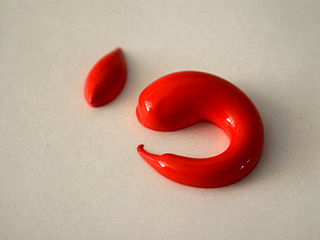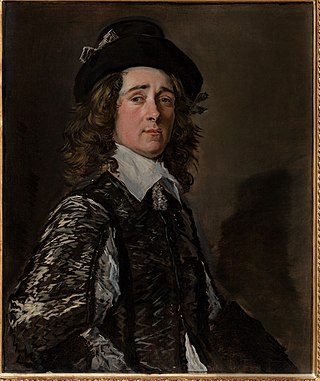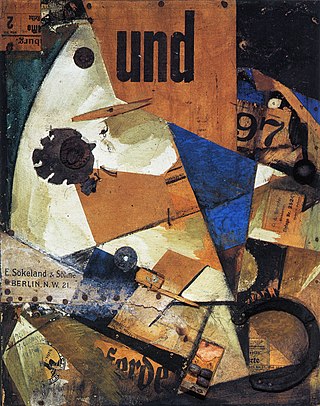
Acrylic paint is a fast-drying paint made of pigment suspended in acrylic polymer emulsion and plasticizers, silicone oils, defoamers, stabilizers, or metal soaps. Most acrylic paints are water-based, but become water-resistant when dry. Depending on how much the paint is diluted with water, or modified with acrylic gels, mediums, or pastes, the finished acrylic painting can resemble a watercolor, a gouache, or an oil painting, or it may have its own unique characteristics not attainable with other media.

A mural is any piece of graphic artwork that is painted or applied directly to a wall, ceiling or other permanent substrate. Mural techniques include fresco, mosaic, graffiti and marouflage.

In European academic traditions, fine art is made primarily for aesthetics or creative expression, distinguishing it from decorative art or applied art, which also has to serve some practical function, such as pottery or most metalwork. In the aesthetic theories developed in the Italian Renaissance, the highest art was that which allowed the full expression and display of the artist's imagination, unrestricted by any of the practical considerations involved in, say, making and decorating a teapot. It was also considered important that making the artwork did not involve dividing the work between different individuals with specialized skills, as might be necessary with a piece of furniture, for example. Even within the fine arts, there was a hierarchy of genres based on the amount of creative imagination required, with history painting placed higher than still life.

Felt is a textile that is produced by matting, condensing, and pressing fibers together. Felt can be made of natural fibers such as wool or animal fur, or from synthetic fibers such as petroleum-based acrylic or acrylonitrile or wood pulp–based rayon. Blended fibers are also common. Natural fiber felt has special properties that allow it to be used for a wide variety of purposes. It is "fire-retardant and self-extinguishing; it dampens vibration and absorbs sound; and it can hold large amounts of fluid without feeling wet..."

Impasto is a technique used in painting, where paint is laid on an area of the surface thickly, usually thick enough that the brush or painting-knife strokes are visible. Paint can also be mixed right on the canvas. When dry, impasto provides texture; the paint appears to be coming out of the canvas.

Theatrical scenic painting includes wide-ranging disciplines, encompassing virtually the entire scope of painting and craft techniques. An experienced scenic painter will have skills in landscape painting, figurative painting, trompe-l'œil, and faux finishing, and be versatile in different media such as acrylic, oil, and tempera paint. The painter might also be accomplished in three-dimensional skills such as sculpting, plasterering and gilding. To select the optimal materials, scenic painters must also have knowledge of paint composition.
Computer art is art in which computers play a role in production or display of the artwork. Such art can be an image, sound, animation, video, CD-ROM, DVD-ROM, video game, website, algorithm, performance or gallery installation. Many traditional disciplines are now integrating digital technologies and, as a result, the lines between traditional works of art and new media works created using computers has been blurred. For instance, an artist may combine traditional painting with algorithm art and other digital techniques. As a result, defining computer art by its end product can thus be difficult. Computer art is bound to change over time since changes in technology and software directly affect what is possible.

An illustrator is an artist who specializes in enhancing writing or elucidating concepts by providing a visual representation that corresponds to the content of the associated text or idea. The illustration may be intended to clarify complicated concepts or objects that are difficult to describe textually, which is the reason illustrations are often found in children's books.
Video game art is a specialized form of computer art employing video games as the artistic medium. Video game art often involves the use of patched or modified video games or the repurposing of existing games or game structures, however it relies on a broader range of artistic techniques and outcomes than artistic modification and it may also include painting, sculpture, appropriation, in-game intervention and performance, sampling, etc. It may also include the creation of art games either from scratch or by modifying existing games.

Pixel art is a form of digital art drawn with graphical software where images are built using pixels as the only building block. It is widely associated with the low-resolution graphics from 8-bit and 16-bit era computers, arcade machines and video game consoles, in addition to other limited systems such as LED displays and graphing calculators, which have a limited number of pixels and colors available. The art form is still employed to this day by pixel artists and game studios, even though the technological limitations have since been surpassed.
Concept art is a form of visual art used to convey an idea for use in films, video games, animation, comic books, television shows, or other media before it is put into the final product. Concept art usually refers to world-building artwork used to inspire the development of media products, and is not the same as visual development art, though they are often confused.

Body painting is a form of body art where artwork is painted directly onto the human skin. Unlike tattoos and other forms of body art, body painting is temporary, lasting several hours or sometimes up to a few weeks. Body painting that is limited to the face is known as face painting. Body painting is also referred to as "temporary tattoo". Large scale or full-body painting is more commonly referred to as body painting, while smaller or more detailed work can sometimes be referred to as temporary tattoos.

Wet-on-wet, or alla prima, direct painting or au premier coup, is a painting technique in which layers of wet paint are applied to previously administered layers of wet paint. Used mostly in oil painting, the technique requires a fast way of working, because the work has to be finished before the first layers have dried.

Graphic art software is a subclass of application software used for graphic design, multimedia development, stylized image development, technical illustration, general image editing, or simply to access graphic files. Art software uses either raster or vector graphic reading and editing methods to create, edit, and view art.

Painting is a visual art, which is characterized by the practice of applying paint, pigment, color or other medium to a solid surface. The medium is commonly applied to the base with a brush, but other implements, such as knives, sponges, and airbrushes, can be used.

Collage is a technique of art creation, primarily used in the visual arts, but in music too, by which art results from an assemblage of different forms, thus creating a new whole.

Kalamkari is a type of hand-painted cotton textile produced in the Indian state of Andhra Pradesh. Only natural dyes are used in Kalamkari, which involves twenty-three steps.

New media art includes artworks designed and produced by means of electronic media technologies. It comprises virtual art, computer graphics, computer animation, digital art, interactive art, sound art, Internet art, video games, robotics, 3D printing, immersive installation and cyborg art. The term defines itself by the thereby created artwork, which differentiates itself from that deriving from conventional visual arts such as architecture, painting or sculpture.

The visual arts are art forms such as painting, drawing, printmaking, sculpture, ceramics, photography, video, filmmaking, comics, design, crafts, and architecture. Many artistic disciplines, such as performing arts, conceptual art, and textile arts, also involve aspects of the visual arts as well as arts of other types. Also included within the visual arts are the applied arts, such as industrial design, graphic design, fashion design, interior design, and decorative art.

Alexia Guggémos, is a French art critic, curator, writer and digital sociologist. The Art Gorgeous Magazine ranked her in the top 20 most influential women of the French art scene (2019).




































